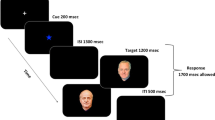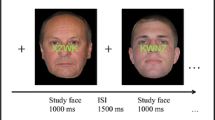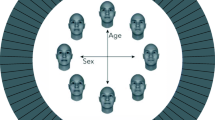Abstract
Familiarity and face inversion not only affect face recognition and memory but also influence attention. Face processing is less attention-demanding for familiar than for unfamiliar faces and for upright than for inverted faces. The automaticity raises the question of how face processing interacts with an increase in attention. Using a dual-task paradigm, we tested the interaction between attention and face familiarity and orientation. Participants encoded a series of faces to memory while simultaneously monitoring a stream of colored squares, pressing the space bar for target-colored squares and making no response to distractor-colored squares. Replicating previous findings of the attentional boost effect (ABE), we found that faces encoded with target squares were better remembered than faces encoded with distractor squares. If the automatic nature of familiar (or upright) face processing makes attention unnecessary, then the attentional boost should be attenuated for familiar relative to unfamiliar faces and for upright relative to inverted faces. Data from three experiments showed, however, that the ABE was the same for all types of faces. These results suggest that target detection did not simply elevate attention in an early encoding phase. Rather, selecting targets and rejecting distractors in the color task may have led to yoked temporal selection of target-concurrent faces for entry into memory.

Similar content being viewed by others
Data availability
Experimental data in an aggregated format as well as videos and data files verifying the accuracy of the computer code are available on Open Science Framework https://osf.io/9hyce/.
Code availability
Experimental codes and the famous faces used in the study are available from the authors by request. Unfamiliar faces are drawn from image databases maintained by others (see Methods).
References
Anderson, A. K. (2005). Affective influences on the attentional dynamics supporting awareness. Journal of Experimental Psychology: General, 134(2), 258–281. https://doi.org/10.1037/0096-3445.134.2.258
Aston-Jones, G., & Cohen, J. D. (2005). An integrative theory of locus coeruleus-norepinephrine function: Adaptive gain and optimal performance. Annual Review of Neuroscience, 28(1), 403–450. https://doi.org/10.1146/annurev.neuro.28.061604.135709
Bindemann, M., & Burton, A. M. (2008). Attention to upside-down faces: An exception to the inversion effect. Vision Research, 48(25), 2555–2561. https://doi.org/10.1016/j.visres.2008.09.001
Criss, A. H., & Malmberg, K. J. (2008). Evidence in favor of the early-phase elevated-attention hypothesis: The effects of letter frequency and object frequency. Journal of Memory and Language, 59(3), 331–345. https://doi.org/10.1016/j.jml.2008.05.002
Dienes, Z. (2014). Using Bayes to get the most out of non-significant results. Frontiers in Psychology, 5, 781. https://doi.org/10.3389/fpsyg.2014.00781
Duchaine, B., & Yovel, G. (2015). A revised neural framework for face processing. Annual Review of Vision Science, 1(1), 393–416. https://doi.org/10.1146/annurev-vision-082114-035518
Duncan, J. S. (1980). The locus of interference in the perception of simultaneous stimuli. Psychological Review, 87(3), 272–300. https://doi.org/10.1037/0033-295x.87.3.272
Faul, F., Erdfelder, E., Lang, A. G., & Buchner, A. (2007). G*Power 3: A flexible statistical power analysis program for the social, behavioral, and biomedical sciences. Behavior Research Methods, 39(2), 175–191. https://doi.org/10.3758/bf03193146
Glanzer, M., & Adams, J. H. (1990). The mirror effect in recognition memory: Data and theory. Journal of Experimental Psychology: Learning, Memory and Cognition, 16(1), 5–16. https://doi.org/10.1037/0278-7393.16.1.5
Jackson, M., & Raymond, J. E. (2006). The role of attention and familiarity in face identification. Attention, Perception, & Psychophysics, 68(4), 543–557. https://doi.org/10.3758/bf03208757
Jiang, Y. V., & Swallow, K. M. (2014). Temporal yoking in continuous multitasking. Journal of Experimental Psychology: Human Perception and Performance, 40(6), 2348–2360. https://doi.org/10.1037/a0038286
Kinchla, R. A. (1991). Attention. Annual Review of Psychology, 43(1), 711–742. https://doi.org/10.1146/annurev.ps.43.020192.003431
Kramer, R. S., Young, A. W., & Burton, A. M. (2018). Understanding face familiarity. Cognition, 172, 46–58. https://doi.org/10.1016/j.cognition.2017.12.005
Lavie, N., Ro, T., & Russell, C. (2003). The role of perceptual load in processing distractor faces. Psychological Science, 14(5), 510–515. https://doi.org/10.1111/1467-9280.03453
Lin, J., Pype, A., Murray, S. A., & Boynton, G. M. (2010). Enhanced memory for scenes presented at behaviorally relevant points in time. PLOS Biology, 8(3), e1000337. https://doi.org/10.1371/journal.pbio.1000337
Ma, D. S., Correll, J., & Wittenbrink, B. (2015). The Chicago Face Database: A free stimulus set of faces and norming data. Behavior Research Methods, 47, 1122–1135. https://doi.org/10.3758/s13428-014-0532-5
Makovski, T., Swallow, K. M., & Jiang, Y. V. (2011). Attending to unrelated targets boosts short-term memory for color arrays. Neuropsychologia, 49(6), 1498–1505. https://doi.org/10.1016/j.neuropsychologia.2010.11.029
Megreya, A. M., & Burton, A. M. (2006). Unfamiliar faces are not faces: Evidence from a matching task. Memory & Cognition, 34, 865–876. https://doi.org/10.3758/BF03193433
Morey, R. D., & Rouder, J. N. (2011). Bayes factor approaches for testing interval null hypotheses. Psychological Methods, 16(4), 406–419. https://doi.org/10.1037/a0024377
Mulligan, N. W., Spataro, P., & Picklesimer, M. (2014). The attentional boost effect with verbal materials. Journal of Experimental Psychology: Learning, Memory and Cognition, 40(4), 1049–1063. https://doi.org/10.1037/a0036163
Olk, B., & Garay-Vado, A. M. (2011). Attention to faces: Effects of face inversion. Vision Research, 51(14), 1659–1666. https://doi.org/10.1016/j.visres.2011.05.007
Parketny, J., & Eimer, M. (2015). Effects of stimulus inversion on the attentional selection and working memory encoding of individual faces. Journal of Vision, 15(12), 680. https://doi.org/10.1167/15.12.680
Pascucci, D., & Turatto, M. (2013). Immediate effect of internal reward on visual adaptation. Psychological Science, 24(7), 1317–1322. https://doi.org/10.1177/0956797612469211
Pashler, H. (1994). Dual-task interference in simple tasks: Data and theory. Psychological Bulletin, 116(2), 220–244. https://doi.org/10.1037/0033-2909.116.2.220
Peirce, J., Gray, J. R., Simpson, S., MacAskill, M., Höchenberger, R., Sogo, H., ..., Lindeløv, J. K. (2019). PsychoPy2: Experiments in behavior made easy. Behavior Research Methods, 51(1), 195–203. https://doi.org/10.3758/s13428-018-01193-y
Prull, M. W. (2019). The attentional boost effect for words in young and older adults. Psychology and Aging, 3(34), 405–417. https://doi.org/10.1037/pag0000337
Rossi-Arnaud, C., Spataro, P., Costanzi, M., Saraulli, D., & Cestari, V. (2017). Divided attention enhances the recognition of emotional stimuli: Evidence from the attentional boost effect. Memory, 26(1), 42–52. https://doi.org/10.1080/09658211.2017.1319489
Seitz, A. R., & Watanabe, T. (2003). Is subliminal learning really passive? Nature, 422(6927), 36. https://doi.org/10.1038/422036a
Sisk, C. A., & Lee, V. G. (2022). Concurrent target detection is associated with better memory for object exemplars. Psychonomic Bulletin & Review 29, 159–168. https://doi.org/10.3758/s13423-021-01983-0
Smith, S. A., & Mulligan, N. W. (2018). Distinctiveness and the attentional boost effect. Journal of Experimental Psychology: Learning, Memory and Cognition, 44(9), 1464–1473. https://doi.org/10.1037/xlm0000531
Spataro, P., Mulligan, N. W., & Rossi-Arnaud, C. (2015). Limits to the attentional boost effect: The moderating influence of orthographic distinctiveness. Psychonomic Bulletin & Review, 22(4), 987–992. https://doi.org/10.3758/s13423-014-0767-2
Swallow, K. M., Broitman, A., Riley, E. C., & Turker, H. B. (2022). Grounding the attentional boost effect in events and the efficient brain. Frontiers in Psychology, 13, 892416. https://doi.org/10.3389/fpsyg.2022.892416
Swallow, K. M., & Jiang, Y. V. (2010). The attentional boost effect: Transient increases in attention to one task enhance performance in a second task. Cognition, 115(1), 118–132. https://doi.org/10.1016/j.cognition.2009.12.003
Swallow, K. M., & Jiang, Y. V. (2011). The role of timing in the attentional boost effect. Attention, Perception, & Psychophysics, 73(2), 389–404. https://doi.org/10.3758/s13414-010-0045-y
Tatler, B. W., Wade, N., Kwan, H. S., Findlay, J. B. C., & Velichkovsky, B. M. (2010). Yarbus, eye movements, and vision. I-Perception, 1(1), 7–27. https://doi.org/10.1068/i0382
Toh, Y. N., & Lee, V. G. (2022). Both target detection and response contribute to the attentional boost effect. Journal of Experimental Psychology: Human Perception and Performance, 48(11), 1239–1249. https://doi.org/10.1037/xhp0001048
Toh, Y. N., & Lee, V. G. (2022). Response, rather than target detection, triggers the attentional boost effect in visual search. Journal of Experimental Psychology: Human Perception and Performance, 48(1), 77–93. https://doi.org/10.1037/xhp0000977
Vuilleumier, P., & Driver, J. (2007). Modulation of visual processing by attention and emotion: Windows on causal interactions between human brain regions. Philosophical Transactions of the Royal Society B, 362(1481), 837–855. https://doi.org/10.1098/rstb.2007.2092
Wolfe, J. (2007). Guided Search 4.0: Current progress with a model of visual search. Research Gate.
Yan, X., Young, A. J., & Andrews, T. J. (2017). The automaticity of face perception is influenced by familiarity. Attention, Perception, & Psychophysics, 79(7), 2202–2211. https://doi.org/10.3758/s13414-017-1362-1
Yarbus, A. L. (1966). Eye movements during perception of complex objects. Eye movements and vision (pp. 171–211). Springer, US EBooks. https://doi.org/10.1007/978-1-4899-5379-7_8
Yebra, M., Galarza-Vallejo, A., Soto-León, V., Gonzalez-Rosa, J. J., De Berker, A. O., Bestmann, S., ..., Strange, B. A. (2019). Action boosts episodic memory encoding in humans via engagement of a noradrenergic system. Nature Communications, 10(1), Article 3534. https://doi.org/10.1038/s41467-019-11358-8
Yin, R. K. (1969). Looking at upside-down faces. Journal of Experimental Psychology, 81(1), 141–145. https://doi.org/10.1037/h0027474
Young, A. J., & Burton, A. M. (2018). Are we face experts? Trends in Cognitive Sciences, 22(2), 100–110. https://doi.org/10.1016/j.tics.2017.11.007
Young, A. J., Hellawell, D. J., & Hay, D. C. (1987). Configurational information in face perception. Perception, 16(6), 747–759. https://doi.org/10.1068/p160747
Acknowledgments
This study was supported in part by a Graduate Research Fellowship. The authors declare no conflicts of interest to disclose. The data supporting the findings of this study are available in aggregate form at the following link: https://osf.io/9hyce/. Study materials are available by request. The study was not preregistered
Funding
Graduate Research Award, Department of Psychology, University of Minnesota
Author information
Authors and Affiliations
Contributions
A.W.O. and V.G.L. designed the experiments. A.W.O. coded the experiments, verified code accuracy, performed the experiments, analyzed the data, and prepared files for OSF under the supervision of V.G.L. A.W.O. and V.G.L. wrote the manuscript.
Corresponding author
Ethics declarations
Conflicts of interest/Competing interests
None.
Ethics approval
The study received approval from the Institutional Review Board of the University of Minnesota
Consent to participate
All participants provided informed consent via Qualtrics.
Consent for publication
Not applicable.
Additional information
Publisher's note
Springer Nature remains neutral with regard to jurisdictional claims in published maps and institutional affiliations.
Rights and permissions
Springer Nature or its licensor (e.g. a society or other partner) holds exclusive rights to this article under a publishing agreement with the author(s) or other rightsholder(s); author self-archiving of the accepted manuscript version of this article is solely governed by the terms of such publishing agreement and applicable law.
About this article
Cite this article
Oliver, G.W., Lee, V.G. The generality of the attentional boost effect for famous, unfamiliar, and inverted faces. Psychon Bull Rev 31, 234–241 (2024). https://doi.org/10.3758/s13423-023-02346-7
Accepted:
Published:
Issue Date:
DOI: https://doi.org/10.3758/s13423-023-02346-7




